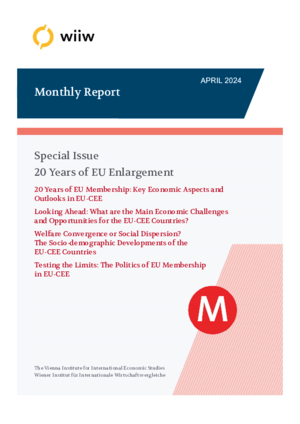Monthly Report No. 04/2024
Marcus How, Sebastian Leitner, Tamás Szemlér, Maryna Tverdostup and Zuzana Zavarská
wiiw Monthly Report No. 4, April 2024
63 pages including 1 Table and 37 Figures
Special Issue
20 Years of EU Enlargement
- 20 Years of EU membership: Key economic aspects and outlooks in EU-CEE
by Tamás Szemlér
Accession to the European Union in 2004 was a long-awaited historical event for eight Central and East European countries. After 20 years of membership, one can say that some expectations related to the economic benefits of membership have come true, but some others have not. Beyond a positive overall economic balance, the performance of the individual countries has not been uniform. For example, there are differences in terms of the pace of catching up as well as regarding membership in the euro area. In addition, political conflicts during recent crises have made the divisions in the region even more tangible.
- Looking ahead: what are the main economic challenges and opportunities for the EU-CEE countries?
by Zuzana Zavarská
EU-CEE’s development path following EU accession is a success story that should not be downplayed. Yet, 20 years on, it is time for these countries to formulate a new strategy for their economic model. With the right set of industrial policies, EU-CEE can become a more strategic player in EU value chains, increase its resilience to external shocks, close the remaining gaps with Western Europe and, ultimately, enhance the well-being of its populations.
- Welfare convergence or social dispersion? The socio-demographic developments of the EU CEE countries
by Sebastian Leitner and Maryna Tverdostup
Following their accession to the EU, the CEE countries have continued to make up ground in economic terms. However, in terms of overall welfare, the pace of their catching up has been mixed and less rosy in some areas. An important factor behind this has been demographic developments that were strongly driven by migration flows, resulting in sharply falling unemployment and rising labour shortages. Still, some of the countries (e.g. the Baltic states, Bulgaria and Romania) feature considerably higher levels of relative poverty and lower levels of public expenditures in comparison to the EU average.
- Testing the limits: The politics of EU membership in EU-CEE
by Marcus How
Surveys indicate that local populations in EU-CEE remain broadly positive about EU membership. Apathy is high, however, and trust in national institutions remains low. Combined with ‘convergence fatigue’, these factors have created favourable conditions for populist forces, which have degraded the quality of institutions in numerous states. These forces are qualified in their Euroscepticism in that they favour EU membership for pragmatic reasons. Nevertheless, such attitudes will prove unsustainable in the long term, as the case of Hungary is now demonstrating.
- Monthly and quarterly statistics for Central, East and Southeast Europe
Reference to wiiw databases: wiiw Annual Database, wiiw Monthly Database, wiiw FDI Database
Keywords: EU membership, economic convergence, foreign trade, EU financial support, accession to euro area, regional disparities, green transition, automation and digitalisation, industrial policy, demography, migration, labour markets, welfare models, opinion polls, institutional quality
Countries covered: EU-CEE
Research Areas: Macroeconomic Analysis and Policy, Labour, Migration and Income Distribution, International Trade, Competitiveness and FDI
